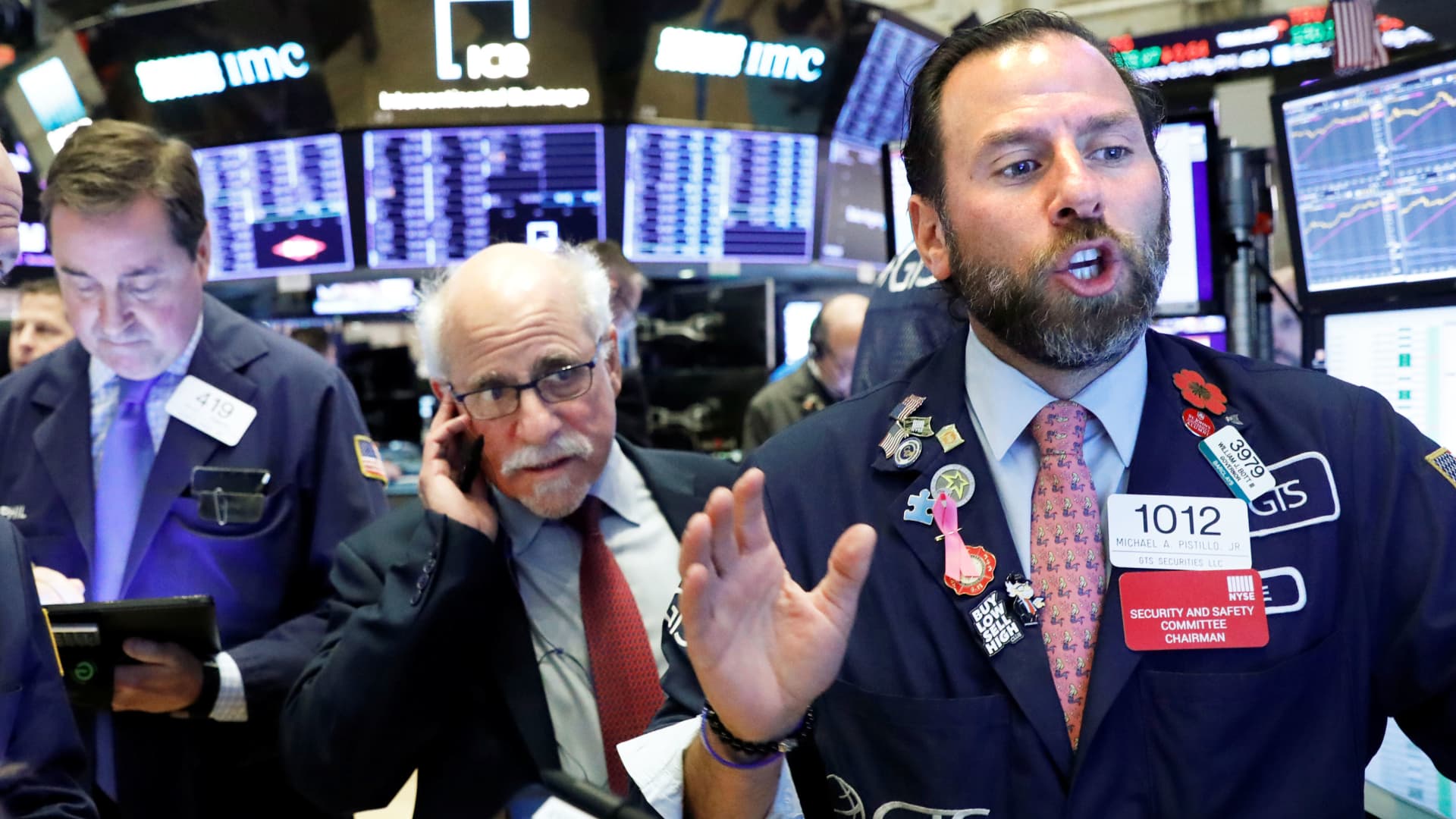US Markets
Friday, July 1st, 2022 5:18 pm EDT

Investors are greeting the third quarter with greater trepidation about a recession, and that makes next Friday’s June jobs report a potentially bigger catalyst for markets than it might otherwise have been.
The jobs report and Wednesday’s release of minutes from the Federal Reserve’s last interest rate meeting are expected to highlight the four-day, post-holiday week.
June’s nonfarm payrolls are expected to have slowed from the 390,000 added in May, but still show solid job growth and a strong labor market. According to Dow Jones, economists expect 250,000 payrolls were added in June and the unemployment rate held steady at 3.6%.
But economists expect to see a slowing in employment data, as the Fed’s tighter rates policy squeezes employers and the economy. There is a chance some of those cracks in the labor market could start to appear on Friday. Some slowing would be seen as a positive, but there’s a balance between a slower, less hot job market and one that has gotten too cool.
“Employment should slow from May. Whether it goes to 250,000 consensus or more, there’s always volatility,” said David Page, head of macro economic research at AXA Investment Managers. “The trend is going to be lower, and I wouldn’t mind betting it would be in 150,000 to 200,000 by early Q3, and it could be certainly lower by the end of the year.”
A rate of 150,000 to 200,000 is still strong and closer to the pre-pandemic pace of job growth.
Page said there has been a slowing in other data, including consumer spending, income and the employment component of the ISM June manufacturing survey. The employment component fell for a third month to 47.3. A level under 50 signals contraction.
Loading chart…
“That’s part of a trend we’re seeing emerge. It’s very evidently a slowdown in the economy,” Page said. “The warning signs are starting to emerge, and the more we see those warning signs start to trickle into the labor market, the more the Federal Reserve is going to have to take heed and that’s what puts such focus on next Friday’s payroll report.”
On the other hand, if the jobs number is particularly strong, markets could react negatively since it would mean the Fed would feel forced to move ahead aggressively to fight inflation with larger rate hikes.
Fed impact
“If the employment data is strong, and the Fed officials on paper sound as hawkish as they do verbally, I would think that would continue to put pressure on the market,” said Sam Stovall, chief investment strategist at CFRA. “If one of the major barometers of how well higher rates are affecting the economy does not show, it is affecting the economy. The implication or inference would be the Fed still has more to go.”
Many economists expect the Fed will raise interest rates by another 75 basis points at its next policy meeting in late July, but the path for September is less certain. A basis point equals 0.01%.
Page said he expects the Fed will debate the size of July’s hike more than the market believes, and the central bank could end up raising rates by a lower-than-expected 50 basis points. Page expects the Fed to be sensitive to the slowing economy and tightening of financial conditions.
He noted there are few instances in history where the Fed has managed “a soft landing on such a narrow landing strip.”
A major issue for markets is that the economy can easily fall into recession, and it can be hard to predict. This week market pros became more concerned about an economic downturn, after weaker data and comments from Fed Chair Jerome Powell. Powell indicated the Fed will do what it needs with interest rate hikes to tame inflation, triggering worries policymakers will be willing to bring on a recession to slow price increases.
“You can be traveling along, then you hit a certain tipping point,” Page said. “It starts with something as amorphous as market sentiment. The market sentiment starts to evaporate. …That’s when financial conditions start to tighten. … That has a knock on to economic activity.”
Economists are divided on when and whether the economy will enter a recession, but increasingly markets are pricing in an economic contraction.
The Atlanta Fed’s GDP Now tracker shows the economy is already in a recession, with a forecast of gross domestic product declining 2.1% in the second quarter. If that forecast were accurate, it would make for a second negative quarter in a row, or what’s considered a recession on Wall Street. The first quarter contracted by 1.6%.
Other economists, however, are not forecasting a recession for the current period, and Page sees 1.5% growth in the second quarter.
New test for stocks?
Stocks in the past week were sharply lower, as Treasury yields also fell on recession expectations. The 10-year yield stood at 2.89% on Friday, tumbling from 3.49% just two weeks ago. Some strategists had expected to see an up week for stocks as portfolio managers bought equities to rebalance their portfolios at the end of the second quarter.
The S&P 500 rallied 1.1% Friday but was off 2.2% for the week, ending at 3,825. The Nasdaq Composite gained 0.9% Friday, but was down 4.1% for the week.
Loading chart…
“Right now, the market is trying to stabilize with some real quarterly flows,” said Scott Redler, partner with T3Live.com. Redler said if the start of the new quarter and month does not bring in fresh money and support the market in the next several sessions, that will be a negative sign for stocks and could signal that the market will soon test its lows.
“I think the market is caught between two narratives,” said Redler. “I don’t know if it wants good news or bad news. At first, the hot economic news was bad because the Fed could go another 75 basis points and keep going, but now the market wants softer news. But is the landing going to be soft or hard? It’s like threading the needle right now.”
Redler said he believes the market is in the “seventh inning of this correction.”
“If you haven’t sold yet, it’s probably not the time to do it. At this point, it’s a high probability that we test the [S&P 500] low of 3,638, and then it’s just a question of whether we make new lows,” he said. “A lot of people are focused on 3,400 on the S&P 500.”
Strategists say the market will also focus on earnings season, and many expect a choppy reaction once companies begin reporting and lowering future profit guidance. Earnings begin with big banks reporting July 14 and 15.
“The only bullish narrative the market has right now is it can go up on bad news,” said Redler. “At this point, it’s just a matter of how long this contraction will go that the Fed started. They wanted this.”
Week ahead calendar
Monday
July Fourth holiday
Markets closed
Tuesday
10:00 a.m. May factory orders
Wednesday
9:00 a.m. New York Fed President John Williams
9:45 a.m. S&P Global services June PMI
10:00 a.m. ISM June services
10:00 a.m. May JOLTS
2:00 p.m. FOMC minutes
Thursday
8:15 a.m. ADP employment
8:30 a.m. Initial jobless claims
8:30 a.m. May trade balance
1:00 p.m. Fed governor Christopher Waller
1:00 p.m. St. Louis Fed President James Bullard
Friday
Earnings: WD-40, Levi Strauss
8:30 a.m. New York Fed President John Williams
8:30 a.m. June employment report
10:00 a.m. May wholesale trade
11:00 a.m. New York Fed President John Williams
3:00 p.m. May consumer credit
This post has been syndicated from a third-party source. View the original article here.




